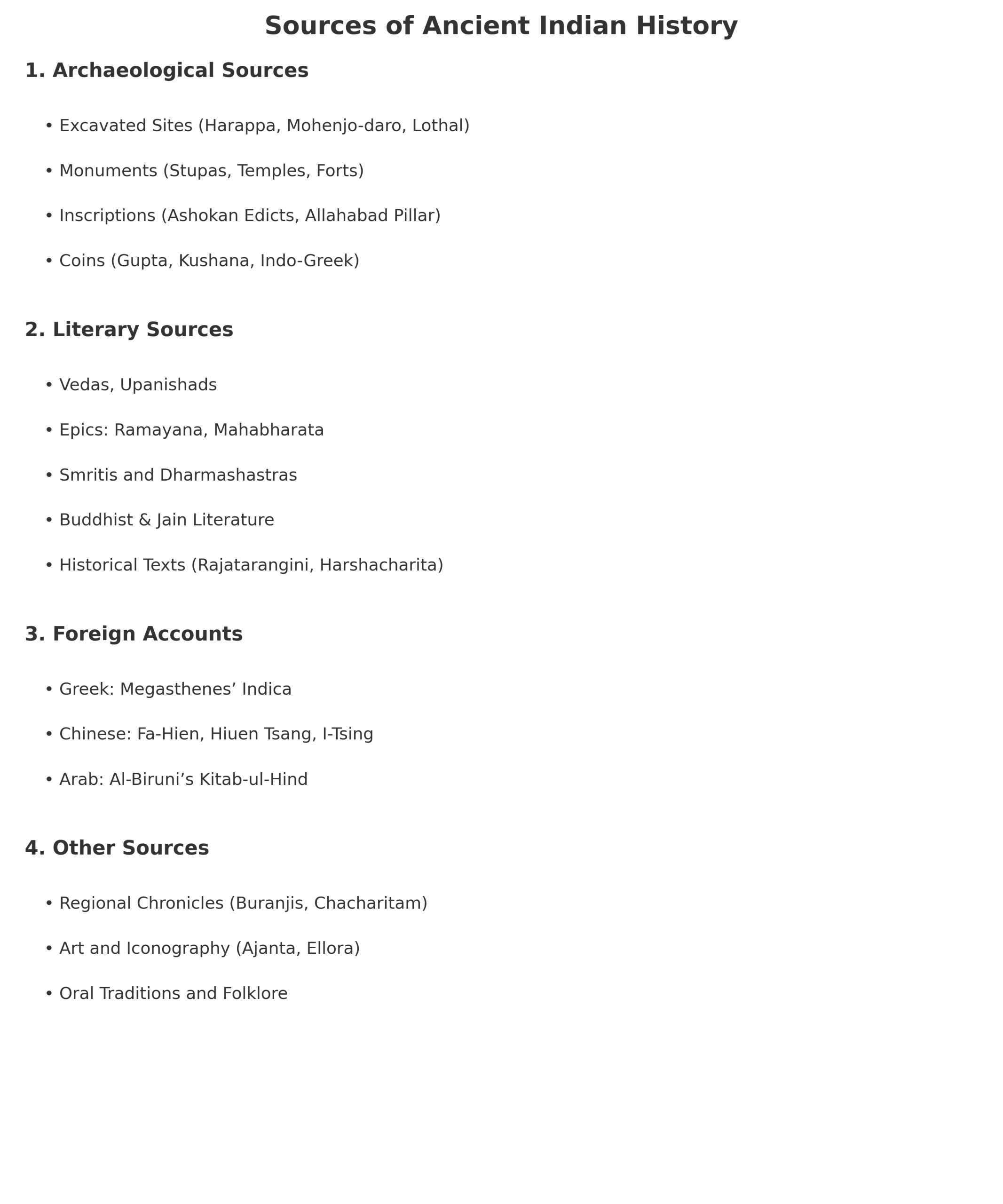
22 Jul Sources of Ancient Indian History
Sources of Ancient Indian History – UPSC History Optional Paper 1
Introduction
The reconstruction of ancient Indian history is a complex and evolving process, reliant on diverse sources ranging from literary texts and inscriptions to archaeological finds and foreign accounts. Each of these categories offers distinct insights into the social, political, religious, and economic conditions of India’s past. The multiplicity of sources not only complements each other but also helps in cross-verifying historical facts. For UPSC aspirants taking History as an optional subject, understanding these sources is fundamental to mastering Paper 1, particularly the section on historiography and methodology.
Best history optional coaching in delhi
1. Archaeological Sources
Archaeology forms the backbone of ancient historical reconstruction. Archaeological sources include material remains such as tools, pottery, monuments, inscriptions, coins, and ruins of ancient settlements.
a. Excavated Sites
Sites like Mohenjo-Daro, Harappa, Kalibangan, and Lothal provide crucial information about the Indus Valley Civilization. The layout of cities, drainage systems, and artifacts reflect advanced urban planning and a high degree of civic organization.
b. Monuments and Architecture
Stupas (Sanchi), caves (Ajanta, Ellora), temples (Mahabalipuram, Khajuraho), and forts (Rajgir) depict religious and political developments, technological advancements, and aesthetic sensibilities of ancient India.
c. Inscriptions
Inscriptions are vital primary sources, often dated and bearing official proclamations or religious messages. Examples:
- Ashokan Edicts: Provide insights into Mauryan administration, Dhamma, and society.
- Allahabad Pillar Inscription: Praises Samudragupta and records his conquests.
- Hathigumpha Inscription: Describes the rule of Kharavela of Kalinga.
d. Numismatics (Coins)
Coins help trace economic transactions, trade routes, monetary policies, rulers’ titles, and religious affiliations. Indo-Greek, Kushana, Gupta, and Satavahana coins are prominent examples.
2. Literary Sources
Ancient Indian literature encompasses religious texts, epics, secular writings, biographies, and chronicles. These sources are crucial for understanding philosophical, political, and social history.
a. Religious Texts
- Vedas: Oldest religious texts, divided into Rigveda, Yajurveda, Samaveda, and Atharvaveda, reflecting early Aryan life.
- Brahmanas, Aranyakas, and Upanishads: Philosophical and ritualistic elaborations.
- Jain and Buddhist Literature: Pali Canon (Tripitaka), Jain Agamas—help reconstruct socio-religious life in the 6th century BCE.
b. Epics
- Ramayana and Mahabharata: Offer insights into values, polity, and kinship in early India.
c. Smritis and Dharmashastras
Manusmriti, Yajnavalkya Smriti, and other law books describe the varna system, duties of kings, and legal traditions.
d. Historical Texts and Biographies
- Kalhana’s Rajatarangini: Considered the first historical chronicle of India, documenting Kashmir’s history.
- Harshacharita by Banabhatta: Biography of Harshavardhana, providing insights into early medieval polity.
- Charaka Samhita and Sushruta Samhita: Medical texts offering glimpses into scientific knowledge.
3. Foreign Accounts
Foreign visitors and travelers to India provide external perspectives, which help cross-verify indigenous records.
a. Greek and Roman Accounts
- Herodotus: Mentioned Indo-Persian interactions.
- Megasthenes’ Indica: Detailed observations on Mauryan administration, society, and customs.
- Ptolemy and Pliny the Elder: Refer to Indian geography and trade.
b. Chinese Pilgrims
- Fa-Hien: Visited during Chandragupta II’s reign; focused on Buddhist institutions and society.
- Hiuen Tsang: Came during Harsha’s reign; provides valuable political and cultural data.
- I-Tsing: Offers insights into monastic discipline and Buddhist practices.
c. Arab and Persian Accounts
- Al-Biruni’s Kitab-ul-Hind: A scientific study of Indian religion, philosophy, and geography.
4. Other Sources
a. Indigenous Chronicles and Regional Literature
- Buranjis of Assam
- Chacharitam in Bengal
- Prabandha Kosha in Gujarat
b. Art and Iconography
Sculptures and murals in caves (Ajanta, Ellora, Elephanta) and temples provide insight into religious symbolism, attire, and culture.
c. Oral Traditions and Folklore
Though less reliable, they preserve popular memory, myths, and local traditions that shaped early Indian society.
5. Critical Evaluation of Sources
Each source has its strengths and limitations:
- Literary sources are rich but often biased, mythical, or lacking chronology.
- Inscriptions and coins are more reliable but limited in scope.
- Archaeology is scientific but interpretation depends on context.
- Foreign accounts offer fresh perspectives but sometimes suffer from cultural misinterpretations.
Thus, a multidisciplinary approach combining all sources is essential for balanced historical reconstruction.
Previous Year Questions from UPSC Mains – History Optional
- 2022: Evaluate the usefulness of early Buddhist literature in reconstructing the history of India.
- 2020: How far do the recent archaeological findings help us in understanding the pre-historic Indian society?
- 2019: Discuss the importance of the accounts of Chinese and Arab travelers in the reconstruction of Indian history.
- 2016: Examine the significance of numismatic evidence in understanding ancient Indian polity.
Probable Questions for Upcoming UPSC Mains (2025)
- Discuss the limitations and challenges in using literary texts as sources of ancient Indian history.
- Critically assess the contribution of epigraphic evidence to the reconstruction of Mauryan administration.
- How do the accounts of foreign travelers help us understand early medieval India?
- Compare the archaeological and literary sources in reconstructing the socio-religious life of ancient India.
- Evaluate the contribution of numismatic sources in understanding the economic history of ancient India.
Conclusion
Ancient Indian history is not preserved in a linear narrative but pieced together from varied and fragmented sources. A thorough understanding of these sources—archaeological, literary, and foreign—allows historians and UPSC aspirants alike to construct a coherent and evidence-based historical narrative. For UPSC History Optional Paper 1, mastery of these sources is not just about memorizing facts but understanding their interpretation, context, and historiographical value.




No Comments